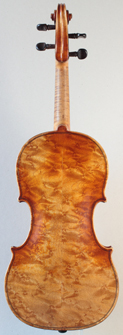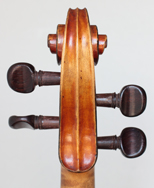Violin by Paul Bailly, Paris, France, 1887
|
|
|
| |||||||||||||||
Description — Charismatic
Every time I look at this Bailly I'm mesmerized by the magnificent bird's eye maple.
From what I've read, that rare type of wood is dense and fragile,
perhaps that's why the maker left the back very thick (5.4 mm in the center).
This one is unbelievably beautiful. Between the "eyes,"
the figure draws silky diamonds, almost like quilted maple.
The two plates of the back are matched
with talent and intelligence: the maple movements flowing and bubbling
from one side to the other, without any eyes/knots in the soundpost area.
Workmanship reveals mastery of technique with elegance and force of character.
The upright, Guarneri-style f-holes look at us with an attitude,
compound by the scroll edges and rib joints picked out in black, and big, fluid purfling.
Arches are moderate,
rising organically but confidently
to a nearly flat middle,
just as you would expect from a fine 19th century French violin.
Tone — Soulful
In this violin, projection happens through glitter
(instead of percussive power like many instruments)
as though a fast vibrato was incorporated into the tone,
sparkling, sizzling, spinning — not unlike the bird's eye figures.
I'll dare to say this violin offers the ideal tone:
mellow under the ear yet very loud,
happy in character although very deep,
full-bodied yet agile,
lovely and consistent in all its registers,
open yet well-contained,
with punch but never aggressive,
both bright and warm,
extremely complex but round.
The dynamic range is huge, with captivating colors throughout. It's almost difficult to produce
a dull tone on this instrument, every note sustains attention with expressive
fervor.
I usually don't believe in this, but...
Occasionally I've had the impression this Bailly was trying to tell me how to interpret the music,
"I've played this before, let me show you."

The violin bears its original label,
with part of Paul Bailly's vitae printed on it.
The year's last digit and violin number are in his hand.
Paul Joseph Bailly (1844-1907) was born near Mirecourt, the French violin-making capital,
but went to Paris to study with the best.
After his internship with Jean-Baptiste Vuillaume, the latter hired him to work on special projects.
Some authors believe the famous Vuillaume violin "golden pheasant" of 1862 (among others) was
in reality made by Paul Bailly. Within the years 1869-1898, Bailly traveled a lot, working and winning competitions
in a multitude of cities, countries and continents. Please look at the reference books for details.
Several of his children worked with him, which explains how more than 2000 instruments came out of his shop.
Interestingly it is a daughter, Jenny, who inherited his business, one of the first professional female
violin makers.
Bibliography
More about Paul Bailly:
- "Paul Bailly" by Robert Lewin, The Strad, December 1981, vol. 92,
no. 1100, pages 581-583.

- Brompton's Fine & Rare Instruments about Paul
Bailly.

- The Cozio Archive about Paul Bailly on
Tarisio.com.

- "The Brompton's Book of Violin and Bow Makers" on Amati.com by John Dilworth, Ed. John Milnes, London, 2012, page 35.
- Violin by Paul Bailly, 1887, Paris, number 449, on Bonhams.com.

- Violin by Paul Bailly, 1890, London, and biography on MartinSwanViolins.com.

- Violin by Paul Bailly, 1891, London, number 675, on Bromptons.co.

- Violin by Paul Bailly, 1891, London, number 707, on Sothebys.com.

- Violin by Paul Bailly, 1900, Paris, number 1073, on TheCooperCollection.co.uk.

- Violin by Paul Bailly, 1902, Paris, number 1132, on The-Saleroom.com.

- "Les Luthiers Français" by Loïc & Verena Le Canu, tome 2,
L & V Le Canu, Paris, 1994, pages 10-11.

- "Les Trésors de la Lutherie Française du XIXe" by Philippe Bodart,
Probomabo Éditeur, 1993, page 82.

- "Violons, Vuillaume", Exhibition Catalog, Cité de la Musique, Paris, October 1998 - January 1999, page 145.
- "Known Violin Makers" by John H. Fairfield, 1942, Virtuoso Publications, Richmond, VA, USA, seventh edition, 2006, pages 5-6 & 257.
- "Universal Dictionary of Violin and Bow Makers" by William Henley, Amati Publishing Ltd, Tunbridge Wells, England, 1973, reprinted 1997, page 70.
- "Die Geigen- und Lautenmacher vom Mittelalter bis zur Gegenwart" on Archive.org by Willibald von Lütgendorff, volume 2, Frankfurter Verlags-Anstalt, Frankfurt am Main, Germany, third edition, 1922, pages 26-27; volume 3 by Thomas Drescher, Verlegt Hans Schneider, Tutzing, Germany, 1990, page 23.
- "Dictionnaire Universel des Luthiers" by René Vannes, volume 1, Les Amis de la Musique, Brussels, second edition, 1951, pages 16-17.
Measurements & Data
Maker: Paul Joseph Bailly (1844-1907)
Made in: Paris, France
Year: 1887
Number: 465
Back Length: 359 mm *
Upper Bouts: 169 mm *
Middle Bouts: 113 mm *
Lower Bouts: 206 mm *
Stop Length: 195 mm
Rib Height at Neck: 30 mm *
Rib Height at Endpin: 31 mm *
Thickness of the Top: 3.9 mm
Thickness of the Back: 5.4 mm
F-hole Length: 78.4 mm *
Distance Between F-holes: 41.5 mm *
Distance Edge-Purfling: 4.5 mm
Scroll Width: 40 mm *
Weight: 420 grams
Label:
10 Médailles Or, Vermeil, Argent et Bronze
à Paris, Sydney, Melbourne, etc.
N°465 PAUL BAILLY (P.B)
LUTHIER
Ancien Élève de J.B.VUILLAUME, de Paris
47, rue de Trévise PARIS Année 1887
Label Translation:
10 Medals Gold, Vermeil, Silver and Bronze
in Paris, Sydney, Melbourne, etc.
#465 PAUL BAILLY (P.B)
VIOLIN MAKER
Former Student of J.B.VUILLAUME, from Paris
47, Trévise street PARIS Year 1887
Inscription: To the back,
"N° 465
Paul Bailly
Paris 1887 ".
Condition: Some wear to the varnish and edges, back middle joint partially reglued, otherwise finely preserved. No cracks. Original neck.
Restoration: Béatrice de Haller, Carouge, Switzerland, 2015.
Certificate: Gilles Chancereul, Paris, France, 2014.
* measured with a caliper
Maker: Paul Joseph Bailly (1844-1907)
Made in: Paris, France
Year: 1887
Number: 465
Back Length: 359 mm *
Upper Bouts: 169 mm *
Middle Bouts: 113 mm *
Lower Bouts: 206 mm *
Stop Length: 195 mm
Rib Height at Neck: 30 mm *
Rib Height at Endpin: 31 mm *
Thickness of the Top: 3.9 mm
Thickness of the Back: 5.4 mm
F-hole Length: 78.4 mm *
Distance Between F-holes: 41.5 mm *
Distance Edge-Purfling: 4.5 mm
Scroll Width: 40 mm *
Weight: 420 grams
Label:
10 Médailles Or, Vermeil, Argent et Bronze
à Paris, Sydney, Melbourne, etc.
N°465 PAUL BAILLY (P.B)
LUTHIER
Ancien Élève de J.B.VUILLAUME, de Paris
47, rue de Trévise PARIS Année 1887
Label Translation:
10 Medals Gold, Vermeil, Silver and Bronze
in Paris, Sydney, Melbourne, etc.
#465 PAUL BAILLY (P.B)
VIOLIN MAKER
Former Student of J.B.VUILLAUME, from Paris
47, Trévise street PARIS Year 1887
Inscription: To the back,
"N° 465
Paul Bailly
Paris 1887 ".
Condition: Some wear to the varnish and edges, back middle joint partially reglued, otherwise finely preserved. No cracks. Original neck.
Restoration: Béatrice de Haller, Carouge, Switzerland, 2015.
Certificate: Gilles Chancereul, Paris, France, 2014.
* measured with a caliper












